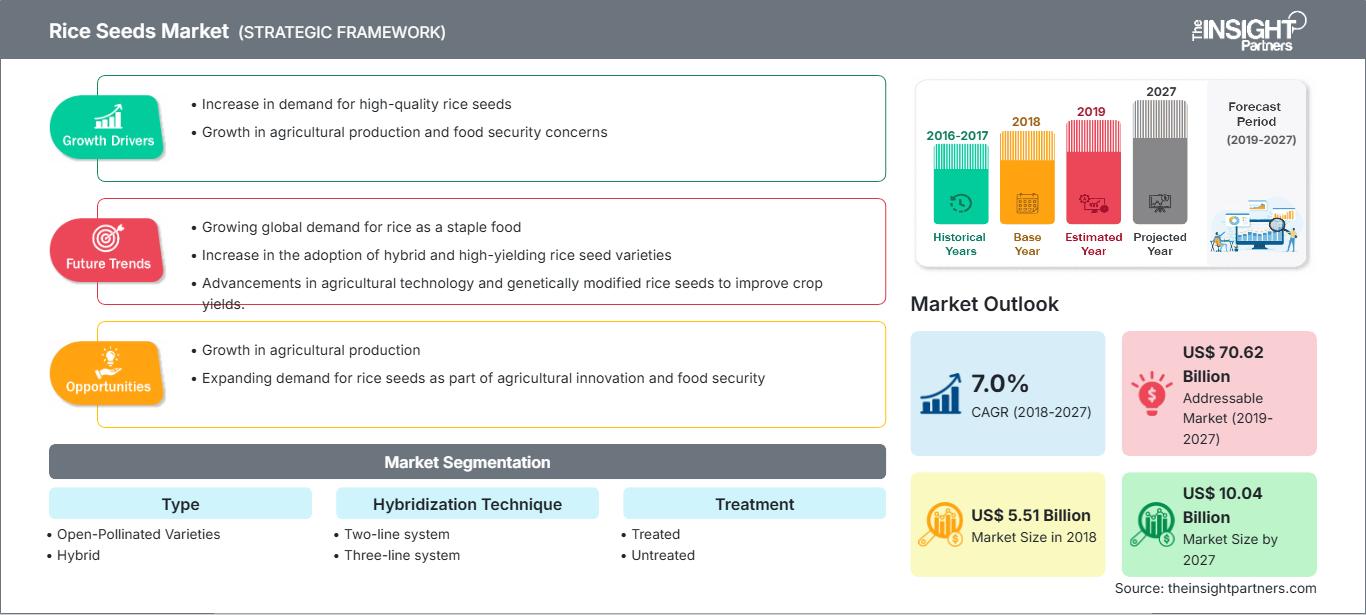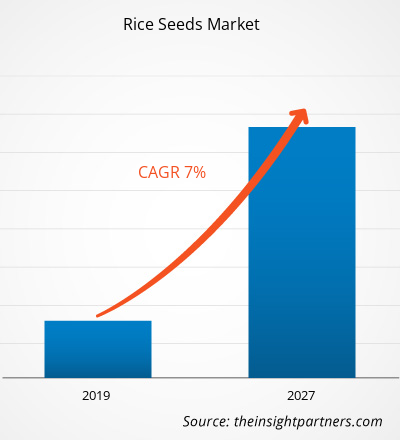Der Markt für Reissamen hatte im Jahr 2018 einen Wert von 5.506,8 Millionen US-Dollar und soll bis 2027 10.036,0 Millionen US-Dollar erreichen; von 2019 bis 2027 wird ein CAGR-Wachstum von 7,0 % erwartet.
Reis ist in vielen großen Ländern, insbesondere im asiatisch-pazifischen Raum, ein Grundnahrungsmittel. Ein Reiskorn, auch Paddy genannt, ist ein ganzer Reissamen, und ein Paddykorn enthält einen Reiskorn. Es handelt sich um einen Samen der Art Oryza glaberrima oder L. Oryza sativa. Reissamen werden außerdem als Bioreaktoren zur Herstellung von Humanarzneimitteln wie Peptiden oder therapeutischen Proteinen verwendet.Der Markt für Reissamen im asiatisch-pazifischen Raum wird im Prognosezeitraum voraussichtlich das höchste CAGR-Wachstum aufweisen. Das Marktwachstum in dieser Region ist hauptsächlich auf die hohe Bevölkerungsdichte zurückzuführen, die insbesondere in Ländern wie Indien und China stetig zunimmt. Hinzu kommt, dass rund ein Viertel der Bevölkerung in asiatischen Ländern arm ist. Diese Länder dürften den Reiskonsum im asiatisch-pazifischen Raum ankurbeln. In Ländern mit hohem Einkommen wie Japan und Südkorea ist der Pro-Kopf-Reiskonsum jedoch rückläufig. Die stetig wachsende Bevölkerung und der Mangel an Anbauflächen sind zwei der wichtigsten Probleme, die auf dem globalen Reissaatgutmarkt angegangen werden müssen. Um den wachsenden Bedarf im asiatisch-pazifischen Raum zu decken, muss die Produktivität des Reisanbaus dringend gesteigert werden.
Passen Sie diesen Bericht Ihren Anforderungen an
Sie erhalten kostenlos Anpassungen an jedem Bericht, einschließlich Teilen dieses Berichts oder einer Analyse auf Länderebene, eines Excel-Datenpakets sowie tolle Angebote und Rabatte für Start-ups und Universitäten.
Markt für Reissamen: Strategische Einblicke

-
Holen Sie sich die wichtigsten Markttrends aus diesem Bericht.Dieses KOSTENLOSE Beispiel umfasst Datenanalysen, die von Markttrends bis hin zu Schätzungen und Prognosen reichen.
Mit der wachsenden Weltbevölkerung wird die Nachfrage nach Reis zur Deckung des steigenden Nahrungsmittelkonsums in den kommenden Jahren voraussichtlich steigen. Aufgrund der begrenzten Verfügbarkeit von Wasser- und Landressourcen stellt die Steigerung der Reisproduktion jedoch eine Herausforderung für Landwirte dar. Die einzige Lösung hierfür ist die Steigerung der Reisproduktivität. In den letzten Jahren stagnierte oder ging die Reisproduktivität in einigen Regionen der Welt zurück, hauptsächlich aufgrund geringfügiger Verbesserungen des Reisertragspotenzials. Die Entwicklung von Hybridsaatgut bietet Ländern eine Lösung, die Reisproduktivität zu steigern und eine Autarkie bei der Reisproduktion zu erreichen. Die zunehmenden technologischen Fortschritte in den Bereichen Molekularbiologie, Biotechnologie und Genomik haben zu erheblichen Verbesserungen in der Hybridreiszüchtung geführt. Darüber hinaus haben die laufenden Investitionen in Forschung und Entwicklung und der zunehmende Trend zu öffentlich-privaten Partnerschaften (ÖPP) im Bereich der Hybridreissaatgutproduktion zu einer verstärkten Nutzung von Hybridsaatgut insbesondere unter kommerziellen Landwirten geführt. All diese Faktoren werden voraussichtlich die Nachfrage nach Hybridsaatgut im Prognosezeitraum antreiben.
Typeneinblicke
Basierend auf den Sorten wird der Markt für Reissaatgut in offen bestäubte Sorten und Hybride unterteilt. Offen bestäubte Reissorten (OPV) sind das Ergebnis der natürlichen Bestäubung der Mutterpflanze. Zu den Bestäubungsmethoden dieser Kategorie gehören Selbstbestäubung und Bestäubung durch Insekten, Vögel und andere natürliche Mittel. Im Gegensatz zu Hybridsaatgut bringen diese Samen Pflanzen hervor, die mit den Mutterpflanzen identisch sind und in einigen Fällen als Standardsorten bezeichnet werden. Die Wahl der OPV hängt von den Anforderungen des Anbauers ab. OPV behalten bei Vermehrung dieselben Eigenschaften, sofern sie effizient gepflegt und produziert werden. OPV-Reissamen weisen genetisch vielfältigere Eigenschaften auf, da sie sich langsam an die Wachstumsbedingungen und das Klima einer Region anpassen. Gewerbliche Anbauer bevorzugen Hybridsaatgut gegenüber OPV wegen des hohen Ertrags und bestimmter gewünschter Eigenschaften. Während Hybridsaatgut einige Vorteile gegenüber OPV bietet, trägt OPV dazu bei, die genetische Vielfalt von Pflanzen zu erhalten. Die weltweit steigende Nachfrage nach natürlich angebautem Reis und anderen Lebensmitteln dürfte den Markt für OPV in den kommenden Jahren ankurbeln.
Einblicke in die Hybridisierungstechnik
Basierend auf der Hybridisierungstechnik ist der Markt für Reissaatgut in Zweiliniensysteme und Dreiliniensysteme segmentiert. Das Segment der Zweiliniensysteme hatte 2018 den größten Marktanteil. Zu den Vorteilen von Zweilinienhybriden gehören, dass keine Erhaltungslinien erforderlich sind, eine breite Auswahl an Elterntieren für die Entwicklung heterotischer Hybride besteht und keine negativen Auswirkungen des sterilen Zytoplasmas auftreten. Die Gesamtproduktion von Zweiliniensaatgut unterscheidet sich nicht sehr von der von Dreilinienhybriden. Eine der wichtigsten Überlegungen bei der Saatgutproduktion von Zweilinienhybriden ist die Bestimmung des geeigneten Standorts oder der geeigneten Jahreszeit. Die Vorteile des Zweiliniensystems werden voraussichtlich die Nachfrage nach Zweilinienhybriden im Prognosezeitraum ankurbeln.
Einige Akteure auf dem Reissaatgutmarkt sind BASF SE, Bayer AG, DuPont de Nemours, Inc., Guard Rice Mills, Kaveri Seeds, Mahyco, Nuziveedu Seeds Limited, Rallis India Limited, Rasi Seeds (P) Ltd. und SL-Agritech, um nur einige zu nennen. Die wichtigsten Unternehmen setzen Fusionen und Übernahmen sowie Forschungs- und Entwicklungsstrategien um, um ihren Kundenstamm zu erweitern und bedeutende Marktanteile auf dem Weltmarkt zu gewinnen. Dies ermöglicht ihnen auch, ihren Markennamen weltweit zu behaupten.
Berichts-Spotlights
- Fortschreitende Branchentrends auf dem Reissamenmarkt, um den Akteuren bei der Entwicklung effektiver langfristiger Strategien zu helfen
- Geschäftswachstumsstrategien in entwickelten und sich entwickelnden Märkten
- Quantitative Analyse des Reissamenmarktes von 2019 bis 2027
- Schätzung der weltweiten Nachfrage nach Reissamen
- PEST-Analyse zur Veranschaulichung der Wirksamkeit von Käufern und Lieferanten in der Branche
- Jüngste Entwicklungen zum Verständnis des Wettbewerbsmarktszenarios
- Markttrends und -aussichten sowie Faktoren, die das Wachstum des Reissamenmarktes fördern und hemmen
- Unterstützung im Entscheidungsprozess durch Hervorhebung von Marktstrategien, die kommerzielle Interessen untermauern und zum Marktwachstum führen
- Die Größe des Reissamenmarktes an verschiedenen Knotenpunkten
- Detaillierte Übersicht und Segmentierung des Marktes sowie die Dynamik der Reissaatindustrie
- Größe des Reissaatmarktes in verschiedenen Regionen mit vielversprechenden Wachstumschancen
Reissaat
Regionale Einblicke in den Markt für ReissamenDie Analysten von The Insight Partners haben die regionalen Trends und Faktoren, die den Markt für Reissaaten im Prognosezeitraum beeinflussen, ausführlich erläutert. In diesem Abschnitt werden auch die Marktsegmente und die geografische Lage in Nordamerika, Europa, dem asiatisch-pazifischen Raum, dem Nahen Osten und Afrika sowie Süd- und Mittelamerika erörtert.
Umfang des Marktberichts über Reissamen
| Berichtsattribut | Einzelheiten |
|---|---|
| Marktgröße in 2018 | US$ 5.51 Billion |
| Marktgröße nach 2027 | US$ 10.04 Billion |
| Globale CAGR (2018 - 2027) | 7.0% |
| Historische Daten | 2016-2017 |
| Prognosezeitraum | 2019-2027 |
| Abgedeckte Segmente |
By Typ
|
| Abgedeckte Regionen und Länder |
Nordamerika
|
| Marktführer und wichtige Unternehmensprofile |
|
Dichte der Marktteilnehmer für Reissamen: Verständnis ihrer Auswirkungen auf die Geschäftsdynamik
Der Markt für Reissaatgut wächst rasant. Die steigende Nachfrage der Endverbraucher ist auf Faktoren wie veränderte Verbraucherpräferenzen, technologische Fortschritte und ein stärkeres Bewusstsein für die Produktvorteile zurückzuführen. Mit der steigenden Nachfrage erweitern Unternehmen ihr Angebot, entwickeln Innovationen, um den Bedürfnissen der Verbraucher gerecht zu werden, und nutzen neue Trends, was das Marktwachstum weiter ankurbelt.

- Holen Sie sich die Markt für Reissamen Übersicht der wichtigsten Akteure
- Offen bestäubte Sorten (OPV)
- Hybrid
Markt für Reissamen – nach Hybridisierungstechnik
- Zweiliniensystem
- Dreiliniensystem
Markt für Reissamen – nach Behandlung
- Behandelt
- Unbehandelt
Markt für Reissamen – nach Korngröße
- Langkorn
- Mittelkorn
- Kurzkorn
Firmenprofile
- BASF SE
- Bayer AG
- EI du Pont de Nemours and Company
- Guard Rice Mills
- Kaveri Seed Company Ltd
- Maharastra Hybrid Seeds Company Private Limited (Mahyco)
- Nuziveedu Seeds Ltd. (NSL)
- Rallis India Limited
- Rasi Seeds (P) Ltd.
- SL Agritech Corporation
- Historische Analyse (2 Jahre), Basisjahr, Prognose (7 Jahre) mit CAGR
- PEST- und SWOT-Analyse
- Marktgröße Wert/Volumen – Global, Regional, Land
- Branchen- und Wettbewerbslandschaft
- Excel-Datensatz
Aktuelle Berichte
Verwandte Berichte
Erfahrungsberichte
Grund zum Kauf
- Fundierte Entscheidungsfindung
- Marktdynamik verstehen
- Wettbewerbsanalyse
- Kundeneinblicke
- Marktprognosen
- Risikominimierung
- Strategische Planung
- Investitionsbegründung
- Identifizierung neuer Märkte
- Verbesserung von Marketingstrategien
- Steigerung der Betriebseffizienz
- Anpassung an regulatorische Trends






















 Kostenlose Probe anfordern für - Markt für Reissamen
Kostenlose Probe anfordern für - Markt für Reissamen